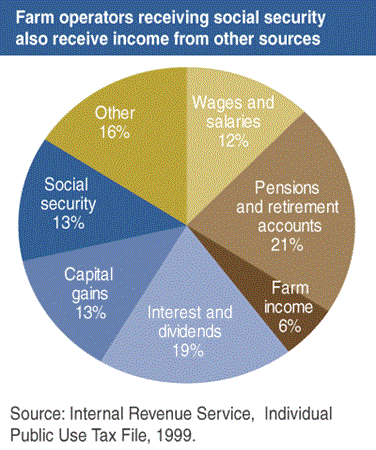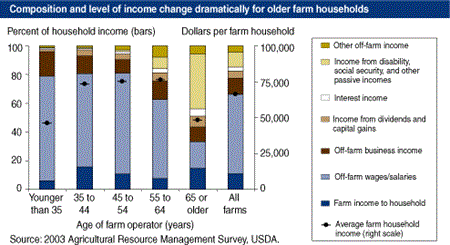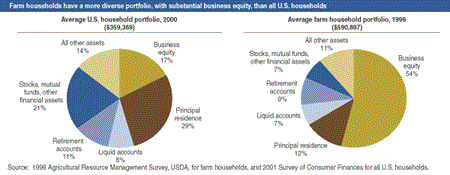How Do U.S. Farmers Plan for Retirement?

The approaching retirement of the baby boom generation has focused attention across all segments of society on issues related to retirement and succession planning. Government policies that can influence this planning and affect retirement income are of increased interest to policymakers. Recent tax initiatives have provided greater incentives for individuals to save for retirement. The Administration has announced that social security reform is among its highest priorities during 2005.
Retirement and succession planning are of considerable importance to farm households and there are good reasons to believe that they are affected by savings and retirement policies in ways that are different from the rest of the Nation’s households. For example, compared with the U.S. labor force, farm operators are considerably older. Over one-fourth of all farmers, and about half of all agricultural landlords, are age 65 or older, compared with only about 3 percent of the overall labor force. Older age-group farm operators and landowners control over one-third of all farm assets and are staying in farming longer than previous generations. Improved health and longevity, combined with technological advances in farming equipment, enable farmers to continue to perform the physical tasks necessary to operate a farm much longer than was true for previous generations. Farming is also becoming popular as a part-time retirement activity.
In addition to working longer past traditional retirement age, farm operator households tend to have several income sources and different forms of wealth, as compared with the general population. Furthermore, because of the nature of the farm business, farm households have different savings habits and more diverse financial portfolios than most other U.S. households. Farm households’ financial portfolios include more personal savings than those of the typical U.S. household and, in general, farm households are also less dependent on social security income during retirement.
Social Security Faces Potential Funding Shortfall
Social security is considered the foundation of the Nation’s retirement income system and is important to the economic well-being of a large portion of the retired population. Social security operates on a pay-as-you-go basis, with current payroll taxes paying for the benefits of current retirees (see “Farmers’ Participation in Social Security Varies”). In recent years, payroll taxes collected have exceeded benefits paid out. The excess is invested in Treasury securities held in a trust fund to pay future benefits. Over time, however, as baby boomers swell the retirement ranks, benefit obligations are projected to exceed payroll taxes, and trust fund assets could be drawn down and eventually exhausted unless changes are made to the current tax or benefit structure. The 2004 Annual Report of the Board of Trustees of the Federal Old-Age and Survivors Insurance and Disability Insurance Trust Funds, issued in March 2004, states that the trust fund reserves will be exhausted in 2042.
Various incremental program changes have been suggested for addressing potential long-term social security funding shortfalls. These include increasing revenue by removing the cap on taxable earnings subject to the old-age portion of the tax, reducing benefits by indexing past annual earnings with changes in prices rather than wages, or increasing the retirement age to reflect the fact that individuals are living longer. The Administration has also proposed a new feature: the creation of personal investment accounts into which individuals would be permitted to divert a portion of their current payroll taxes.
In addition to social security, the retirement income system generally includes employer-sponsored pensions and personal savings. Only about half of the U.S. workforce is covered by private pensions, and the trend is away from pensions that provide a defined benefit to those that provide a benefit that depends upon employee contributions and earnings. In addition, many Americans have little or no private savings. In fact, social security benefits account for more than half of total income for over 60 percent of current social security recipients and are the sole source of income for about 20 percent of all recipients. In contrast, only about a third of farm operators currently collecting benefits receive more than half their income from social security. Among farm operators receiving social security benefits, on average, social security accounts for only about 13 percent of total income. Farm operator households that receive social security benefits also receive significant amounts of income from the farm, as well as from pensions, investment earnings, and income from the sale of both farm and nonfarm assets. The average annual social security benefit received by farm households in 1999 was about $12,300, slightly less than the $13,000 average for all U.S. households.
Farmers Earn Income From a Variety of Sources . . .
Farm households earn income from both farm and off-farm sources. Off-farm income, which accounts for 90 percent of total farm household income, comprises income from off-farm businesses, wages and salaries, interest and dividends, and other sources, such as pensions, annuities, military retirement, unemployment, social security, veterans’ benefits, other public retirement and public assistance programs, and rental income from nonfarm properties. In 2003, the average income for farm households, at $66,000, exceeded that of nonfarm households, at $59,100.
Among all farm households, those headed by operators age 55-64 have the highest income ($76,500). Farm operator households headed by operators age 65 or older receive $18,400, or about 38 percent of total household income, from disability insurance, social security, and other income sources (such as military and veterans’ benefits, other public retirement and public assistance). However, among all U.S. households headed by persons age 65 or older, over 60 percent of total income ($30,400 in 2003) came from these sources.
. . .and Income and Wealth Vary by Age and Farm Type
The composition of farm households’ sources of income varies with farm type. Rural residence farms (where the operator reports being retired or a primary occupation other than farming and gross farm sales are less than $100,000) and intermediate farms (operator reports farming as the major occupation and gross farm sales are less than $250,000) are more dependent on off-farm income than commercial farms (family-operated farms with gross sales in excess of $250,000). On the other hand, commercial farm operator households receive most—80 percent or more—of their income from farming. Commercial farm households tend to operate large farms, produce commodities that are covered under government programs (such as wheat, corn, cotton, and soybeans), and receive a larger share of government commodity program payments.
Household wealth may be acquired through savings, inheritance, or appreciation of household assets. Farm household net worth is measured by the value of combined farm and nonfarm assets (minus debt). Farm household assets are dominated by farm real estate (77 percent), while other physical assets (e.g., off-farm business investments, nonfarm real estate, off-farm houses, recreational vehicles) represent the biggest share of nonfarm assets (33 percent). Farm net worth tends to increase with the age of the operator. For example, the average net worth from farm assets increases from $251,800 for operators under age 35 to $580,000 for those age 65 and older. Similarly, the average net worth from nonfarm assets increases with age of the farm operator, but only up to age 64 ($287,700). It then declines as farm households liquidate assets to support consumption in older ages (65 or older, $202,600). The share of farm net worth to total farm household net worth varies with farm type. On average, farm net worth represents 61 percent of wealth for rural residence farm households, compared with 80 percent for intermediate, and 84 percent for commercial farm households.
On average, farm households have substantially higher wealth ($590,900) than all U.S. households ($359,400), but less than half that of all U.S. self-employed households ($1,258,000), with farm net worth contributing 70 percent of total farm household wealth. Farm household wealth also differs in composition from that of all U.S. households. The portfolio of assets held by farm households is heavily weighted toward farm business assets, while the largest shares among asset portfolios of all U.S. households are primary residences, stocks, and mutual funds.
Retiring farm operator households have substantial wealth as well. For example, the average net worth of farm operators who indicate that they will retire in the next 5 years is about $45,000 more than the average for all farm households. However, a large share of their wealth is in farm assets: average nonfarm net worth of those planning to retire is less than half the average for all farm households ($93,000).
Farm Households Save and Invest for Retirement
More than 50 percent of farm households regularly target current income not used for consumption toward savings and other investment opportunities both on and off the farm. Additionally, 57 percent of farm families reported in 2003 that they are saving for long-term goals, such as retirement, education, or investment in financial markets. Such savings can also finance unexpected future needs, such as financial shortfalls in the farm business, or unexpected health care expenditures.
Farm households, like nonfarm households, have diverse financial portfolios, including assets not part of the farm business. One-fourth of the nonfarm assets are retirement savings accounts. Cash, checking, money market accounts, bonds, and certificates of deposit constitute less than one-fourth of nonfarm assets, as do stocks and mutual funds. The rest of nonfarm assets are held in real estate and businesses aside from the farm, off-farm houses, recreational vehicles, and other assets.
U.S. household retirement savings include both employer-sponsored retirement plans and individual retirement savings plans, such as IRA, 401(k), and Keogh accounts. Only 40 percent of farm households participate in some type of retirement account, compared with 60 percent of all U.S. households. Commercial farm operators are less likely to have an employer-sponsored pension and more likely to receive a larger share of their retirement income from farm assets. Participation rates in retirement savings accounts increase with both income and net worth. Participation is also more likely among families headed by persons under age 65.
Recent tax legislation has attempted to stimulate increased retirement savings. The Economic Growth and Tax Relief Reconciliation Act of 2001 increased the contribution limits for IRA and 401(k) accounts and allowed “catch-up” contributions from workers age 50 and over. While most U.S. taxpayers are eligible to contribute to an IRA, only about 3 percent of all taxpayers actually contribute. The rate for farmers is slightly higher, at about 7 percent. While many households not contributing to an IRA may participate in employer-sponsored retirement plans, many have neither an employer-sponsored plan nor an individual retirement arrangement.
According to data from the 1999 Agricultural Resource Management Survey and 2001 data from the Survey of Consumer Finances, the median values of retirement savings of farm households ($12,500) are larger than those of self-employed nonfarm households ($9,300) and are substantially larger than the median retirement savings of all U.S. households ($300).
The retirement savings pattern for farm households varies with income class, age of the farm operator, net worth, and income from the farm business. The majority of farm households earning $25,000 or more have retirement savings. Farm households with incomes of $100,000 or more have only half as much in retirement savings as self-employed nonfarm households with incomes of $100,000 or more. A similar pattern is observed for variations in net worth. Farm households at lower levels of net worth have more retirement savings than all other U.S. households but have a smaller value in retirement savings at the higher levels of net worth.
| Family characteristics | Farm households | Self-employed nonfarm households | All U.S. households |
|---|---|---|---|
| All families (median value of holdings in dollars) | 12,500 | 9,300 | 300 |
| Age of farm operator/head of household (in years) | |||
| Less than 35 | 2,359 | 0 | 0 |
| 35-44 | 11,218 | 2,800 | 5,000 |
| 45-54 | 22,500 | 26,000 | 8,400 |
| 55-64 | 27,063 | 24,000 | 3,400 |
| 65 and older | 4,500 | 16,500 | 0 |
| Percentiles of net worth | |||
| Less than 252 | 0 | 0 | 0 |
| 25-49.9 | 17,500 | 500 | 0 |
| 50-74.9 | 25,144 | 30,700 | 6,000 |
| 75-89.9 | 32,500 | 136,250 | 42,000 |
| 90-100 | 45,000 | 275,000 | 125,000 |
| 1Retirement savings include IRAs, Keogh plan, 401(k). 2This represents the lowest quartile of farm households based on the total value of their net worth. Source: 1999 Agricultural Resource Management Survey, USDA, for farm households, and 2001 Survey of Consumer Finances, Federal Reserve Board, for nonfarm households. |
|||
Farmers Approaching Retirement Hold Onto Land
Retired and retiring farm operators account for over a fourth of the principal operators of U.S. farm businesses. Their succession decisions and retirement plans are of considerable importance to the farming community and the future structure of agriculture. Continuity of the family farm and the family farm sector is highly dependent on successful intergenerational transfer following the retirement of a farm operator. Intergenerational succession is especially pertinent for farmers who are planning to retire within the next 5 years. Of those operators planning to retire from farming, the average age is 62.
In contemplating retirement from farming, farm households must consider the future of the farm. Tax laws may encourage older farmers to hold onto their land and rent it out for retirement income. Despite reduced tax rates on capital gains associated with the appreciation in farmland values, the prospect of avoiding capital gains taxes on any appreciation prior to death continues to encourage farmland owners to hold the land. Recent changes in Federal estate tax policies that allow larger amounts of property to be transferred at death free of any estate tax further reinforce this incentive. Among farm operators who plan to retire from farming in the next 5 years, about a fifth report that they plan to rent out the farm, and another fifth plan to sell the farm. The remaining operators plan to turn over operations to others or convert their land to other uses. A substantial portion of the 87 million acres owned by the 42 percent of operators planning to either rent or sell their land will likely become available in farmland markets in the next few years.
Farmers Are Ready for Retirement
Farmers, like other employees and business owners, participate in and are eligible for benefits under the social security system. The levels of benefits to farm households are only slightly less than those for all other U.S. households. In addition, since many farmers remain active in farming well beyond retirement age, older farmers have income from a wide variety of sources and, as a result, fewer are dependent primarily upon social security for their financial well-being.
While fewer farm operators are covered by employer-sponsored pensions than are nonfarmers, a majority of farm operators save from current income on a regular basis and have accumulated diversified financial portfolios, including individual retirement savings. This is especially true for lower net worth farm households that have saved more than lower net worth nonfarm households. While higher net worth farm households have accumulated less retirement savings than all U.S. households, as a group these farm operators have accumulated substantial business equity that can be a potential source of retirement income to supplement social security and retirement savings.
<a name='box'></a>Farmers' Participation in Social Security Varies
Social security is financed through payroll taxes paid by employers and their employees, as well as by self-employed individuals. Because farmers often earn income from a variety of farm and off-farm activities, their participation in social security varies.
Currently, 12.4 percent of an employee’s earnings up to $90,000 is paid in payroll taxes by the employee and employer (6.2 percent by each) to finance the social security system. An additional 1.45 percent is paid by both the employee and the employer to finance the Medicare, or hospital insurance, system. In 1999, farm operator households paid about $10 billion in social security taxes (considering both the employer and employee shares) on wages and salaries, primarily from off-farm employment.
Like other self-employed individuals, farmers are subject to the self-employment tax. The self-employment tax is essentially equivalent to the social security and Medicare taxes paid by employees and matched by the employer. The self-employment tax rate is 15.3 percent, consisting of two parts: 12.4 percent for social security (old-age, survivors, and disability insurance) and 2.9 percent for Medicare (hospital insurance). Farmers paid about $2 billion in self-employment taxes on farm and nonfarm self-employment income in 1999.
Participation in social security also varies by type of farm. For example, rural residence farm households participate in the social security system primarily through their off-farm employment and off-farm business ownership. Since many of these farm households report losses from farming, they pay little or no self-employment tax on farm income. On the other hand, intermediate and commercial farm operators are less likely to participate in the social security program through an off-farm job but instead contribute to social security through the self-employment tax on farm earnings.
Income, Wealth, and the Economic Well-Being of Farm Households, by Ashok K. Mishra, Hisham S. El-Osta, Mitch Morehart, James Johnson, and Jeffrey Hopkins, USDA, Economic Research Service, July 2002
The Graying Farm Sector: Legacy of Off-Farm Migration, USDA, Economic Research Service, September 2002, Rural America, Vol. 17, No.3.




